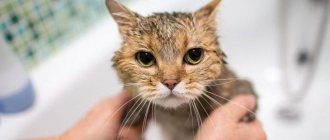Cats by nature are clean animals. Scientists have calculated that purrs devote approximately 3-5 hours a day to licking their fur coats. However, both long-haired and short-haired cats still need to be bathed using special shampoos and running water.
So, for example, Persians and Siberians are usually bathed once every 1.5-2 months or less, and British or Scottish shorthairs - once every 4-6 months. What about hairless cats? How often should you bathe Sphynxes (Don and Canadian), Peterbolts, Ukrainian Levkoys, elves and bambinos? In this article we will figure out whether it is possible to bathe a Sphynx and, if so, how often and how to wash it correctly.
Should a Sphynx be bathed?
Cat hair is not just a pleasant bonus that adorns the body of a purring cat. The fur acts as a protective barrier for the animal. It protects the skin from scratches, and acts as a thermostat in hot and cold weather. The Sphinx does not have such protection. It would be worth rejoicing: the owners do not need to worry about wool hygiene. But it was not there! How to wash a Sphynx, and is it worth doing it at all?
Soft, “velor” to the touch, the skin does not help the cat cope with temperature changes, so nature has rewarded Sphynx cats with high body temperatures. It is 39.5 - 40.5 degrees, while in other breeds it is usually no higher than 38.5 degrees. The sweat glands therefore work more actively, which has its consequences.
Bare skin does not protect the sphinx
Sphynx cats are clean cats, but even frequent washing cannot completely remove the natural lubrication on the body. Small fluff, pieces of litter and food remain on the animal's sticky body. Within 3-4 weeks without bathing, the Sphynx's skin becomes covered with sebum. The cat, without noticing it, leaves marks on the furniture. In addition, a pungent odor appears.
Without timely bathing, a bald cat will not only smell unpleasant, but may also develop skin diseases.
Rules for washing sphinxes
Due to the lack of fur and sensitive skin, bathing sphinxes differs from bathing procedures for furry cats. Washing the Sphynx has its own nuances that the owner needs to take into account.
- There is no need to experiment with the shampoo you use yourself. Even baby shampoo can harm a cat, because it:
A) may cause irritation; B) will not cope with removing sebaceous secretions from the skin of your smooth friend.
Therefore, buy a shampoo that is designed for hairless cats.
Any foaming shampoo will not work
- How to bathe a Sphynx if he is sick? The only correct answer is no. Postpone bath procedures. It seems like you can’t do without swimming? Wipe the cat with wet wipes.
- When preparing for a bath, keep your cat out of the bath. The noise of the water will scare her, which will provoke aggression and disrupt the planned water procedures.
- Do not feed the animal before washing it.
- Vaccinated animals can be bathed two weeks after visiting the veterinarian.
- Reschedule the procedure if the house is cold. Hairless cats are susceptible to cold and may catch a cold. Close all windows while swimming. Even a slight draft can harm your pet.
- If your cat doesn't behave well in the bathroom, trim its nails a few days before bathing. This way you will protect yourself from scratches.
Bath accessories
Before you begin your cat bath, make sure everything you need is in place. To wash your Sphinx comfortably you will need:
- bath or basin;
- To bathe in a basin, you will need a bucket and a ladle to wash off the foam from the animal. In the bathroom, a shower will cope with this role;
The meeting place is the bath!
- soft sponge. Do not use sponges made of hard materials, they can scratch the cat’s delicate skin;
- specialized shampoo for sphinxes;
- several dry towels for drying;
- a towel to cover the bottom of the basin or bathtub;
- a blanket or large bath towel to wrap your pet in to keep warm after the bath;
- floating toys that the animal will be distracted by. The game will relieve stress and calm the animal;
- treats. Praise the animal for calm behavior in the water. If the cat has bitten and scratched, then hold back the treat until better times, otherwise he will develop the wrong behavioral attitude.
Water temperature
Comfortable water temperature for the sphinx is 36 - 38 degrees. But if the room is cool, 38 degrees will seem too high to the animal. Just like humans, cats will be uncomfortable with sudden changes in temperature.
Master, why is the water hot?
Check the water temperature with your hand - the skin should be comfortable. Start bathing at 36 degrees, and increase the temperature, focusing on the cat’s reactions and your feelings. If water is too cold, the animal may get sick, and hot water will cause the sebaceous glands to work harder than usual.
Water is collected so that it covers the cat's paws and barely touches the tummy.
Bathing stages
Bathing cats without hair is divided into three stages.
Preparation. At this stage, we prepare a place for swimming, bath accessories and prepare the cat for water procedures. Before washing, the animal’s eyes and face are wiped with a clean damp cloth, and the ears are cleaned with lotion and a cotton pad. Water in the ears causes discomfort and can lead to otitis media, so before bathing, cotton wool is placed in the Sphynx's ears.
Bathing. We carefully take the cat in our arms and go to the bath. Talk to your pet along the way. Here your task is to provide the cat with psychological comfort and tranquility.
Gently immerse the cat in the water, distracting it with previously prepared toys. When the cat gets used to the water, start soaping it. Wipe the muzzle, eyes and nose with a damp cloth. Make sure that the foam does not flood the animal’s ears and eyes. All your actions must be calm and soft, otherwise the animal will worry.
Master, why is the water hot?
Completion. We take the cat out of the bath or basin and wrap it in a towel for a few minutes. Do not rub your cat in an attempt to speed up drying, as this may cause skin irritation. If all the recommendations were followed the first time and the animal behaved calmly, subsequent bath procedures will be easy.
Once your cat is dry, pat the folds of the skin dry with a dry towel. Make sure that the animal does not run out into the draft in the first hour after bathing.
After bathing, warming up a disgruntled cat
Special cases
Swimming during vaccination
The information that you should not bathe a kitten during the vaccination period is long outdated. According to American veterinary colleagues, you can bathe even on the day of vaccination. Getting water (rain or splashing in the bathroom) onto the injection site does not cause a local inflammatory reaction, but rubbing the injection site with shampoo on the first day is still not recommended. After vaccination, the optimal period for postponing water procedures is a period of 2-3 days.
Treatment for ectoparasites (fleas and ticks)
First of all, it is necessary to take into account the instructions for the drug, which state how many days it is not recommended to bathe the animal. On average, regarding high-quality drugs, you should not bathe for 2 days. This period is due to the fact that the drug settles in the sebaceous glands, i.e. is localized in the deeper layers of the skin, so when swimming, the protective layer of the medicine is not washed off.
Modern dermatologists advise bathing before treatment against ectoparasites, at least 1-2 days in advance. This is especially true for long-haired cats, because the skin takes longer to dry than the fur. It is not recommended to apply the drug to wet skin due to the risk of developing a local inflammatory reaction.
Castration
It is better to bathe a cat 5-7 days after castration. This interval is necessary for the incisions on the scrotum to heal after castration. You can use dry shampoo or wipe with wet wipes. A humid environment is not conducive to healing; besides, cats are very clean creatures and excess moisture on the fur will stimulate grooming of the animal in the groin area.
Sterilization
After sterilization, it is not recommended to bathe the cat for 10 days. This period is necessary for the stitches to heal completely. In some cases, abstaining from swimming requires a period of 14 days. You can also use dry shampoo or wet wipe treatment.
Bathing a nursing cat
It is better to wait until the kittens are about 3 weeks old and then fearlessly separate the nursing mother for several hours: thoroughly bathe and dry. For bathing pregnant or lactating cats, it is best to use hypoallergenic veterinary shampoos or baby soap. Before returning the mother to the kittens, be sure to make sure that the shampoo is thoroughly rinsed off and the animal is dry.
Despite the fact that the cat is a self-sufficient creature. Sometimes even she needs extra care and attention. Some breeds cannot do without human care at all. You should not be afraid to bathe your animal and it is better to accustom your cat to water from childhood.
Frequency of bathing and duration of water procedures
The interval between bathing sphinxes is from two to five weeks. If the animal’s skin becomes greasy and unpleasant to the touch, or an unpleasant odor appears, do not delay washing. Several factors influence the rate of contamination of a cat:
- diet;
- conditions of detention;
- health;
- individual characteristics.
How often you can wash your Sphynx depends on how quickly he gets dirty. However, too frequent bathing will harm the animal. If at least two weeks do not pass between bathing days, the natural protective layer will be washed off from the animal’s skin. Without a thin layer of natural lubricant, a hairless cat's skin is susceptible to irritation and dermatitis.
If your bald friend is dirty and you want to bathe him more often, wet wipes will come to the rescue. The veterinary pharmacy sells wipes that will not harm the delicate skin of the animal. They dissolve sebaceous secretions, disinfect folds vulnerable to bacteria and soothe tender places on your pet's body. Wipe areas that require daily cleaning with a soft cloth, after moistening it with warm water.
The interval between bath procedures should be at least two weeks
Most cats do not like to bathe. The sound of water, unusual sensations and new smells become a stress factor for the Sphinx. Allow no more than ten minutes for swimming. This is enough to lather the graceful cat's body and rinse off the shampoo.
Breed Features
The suede-like skin of a hairless cat is distinguished by the active functioning of the sebaceous and sweat glands. Because of this, the body quickly becomes greasy, especially under the arms and in the folds. Excess skin secretion makes the cat's appearance untidy and leaves brownish stains on light-colored fabrics.
To keep your pet's skin elastic and the velor fluff covering it soft, regular water treatments are required. How often the Sphynx needs to be washed is up to each owner to decide for himself, depending on how dirty his pet gets and taking into account his individual characteristics.
It is advisable to accustom your baby to weekly trips to the bath and daily wiping of the body with a damp towel. If your pet is particularly clean or its skin is not prone to intense sebum secretion, you can reduce the number of bathing sessions to 1-3 per month.
Drying
Due to the lack of long hair, Sphynx cats dry out quickly. But this is not a reason to immediately let them walk around the apartment after a bath. A draft is dangerous for the animal in the first minutes after bathing, so wrap your pet in a dry towel and hold it in your arms. This way the moisture will be absorbed faster.
Don't let your cat freeze after a shower
After this, carefully blot the folds so that there are no areas vulnerable to the cold. A hairdryer is not used to dry sphinxes: they have very delicate skin, and a hot air stream will cause irritation and even burns.
How to wash a Sphynx kitten
Sphynx kittens begin to be accustomed to bathing procedures from the age of one month. But many breeders recommend waiting until the baby is 4 months old so that the kitten’s body gets stronger. In the first weeks of life, the baby’s hygiene is monitored by his mother, and the sweat glands begin to work at full strength only in adults. A very small sphinx will be afraid of water, which in the future may develop a persistent fear of swimming.
How to properly bathe a Sphynx if he is still a kitten? Bathing rules for kittens are the same as for adults. The water should not be hotter than the kitten’s body, the shampoo should be specialized, and the water level should not exceed the level of the cat’s body.
The only difference in washing an adult Sphynx and a kitten is the washing sponge. The Sphynx's skin is too delicate; a sponge can damage it. Kittens sweat less than adults, so you should thoroughly clean your baby's delicate body with your hands.
And while I'm little, my mother will wash me!
Sphynx cats: maintenance and care from the very first days in a new home
The most serious problem of Sphynx kittens is that they are afraid of the cold.
If an ordinary cat will feel quite comfortable at 18-20 degrees, and for long-haired breeds coolness is even preferable, then the Sphynx will feel quite comfortable only at plus 25 and above. Therefore, when purchasing a Sphynx, immediately think: are you ready to live permanently in “Africa”, how will you provide warmth in the off-season. Alternatively, you can dress the kitten. Typically, Sphynx cats do not mind warm clothes - knitted sweaters and pants, flannelette or fleece overalls. If you use a heater to raise the temperature in the room or you have fiery radiators, the sphinx faces another danger - trying to warm up, it can get a serious burn. Place your hand on the battery - if it is impossible to hold it, you will have to either cover the radiator with a cover or protect it from the kitten in some other way.
Already from the conversation about temperature, it is clear that caring for a Sphynx kitten needs to be thought out even before you have a warm velvet lump. Open sunlight also poses a serious danger to a Sphynx cat at any age. Sunbathing on a windowsill can cause a kitten to get heatstroke or even burn out. So in sunny weather, carefully monitor your pet and do not allow him to overuse the tan. Sometimes you even have to shade the windows with a special film.
In the first weeks in the new home, the kitten should be fed the same food that it was accustomed to from the breeder. Find out what kind of food you bought for the kittens and buy the exact same one. Let the supply be sufficient for at least 2 weeks. If the child ate “natural food” - food prepared at home from natural products - find out the exact recipe. You will have to prepare the same one. Even if, in your opinion, the diet was completely wrong, it is better not to change anything in the first few days.
If you adopted a Sphynx as a baby - up to 3-4 months (which can only happen with a very irresponsible breeder), then you will have to feed such a kitten with special food for kittens (not dry) 6 times a day. At first, you will have to get up at night - the baby simply cannot spend 8-10 hours alone without food. To prevent the little Sphynx from freezing and getting bored, many owners put him in bed with them. How should we feel about this? If you, in principle, do not mind the company of a cat in your bed and do not sleep too deeply (there is no risk of crushing the baby in your sleep), there is nothing wrong with that. Just understand that subsequently it will not be possible to convince an adult cat to sleep alone on a special bed.
After 4-5 months, you can feed the Sphynx, like any kitten, 3-4 times a day. And after 8-9 months it is quite possible to switch to 2 meals a day. In between meals, the kitten should always have clean water available. It is recommended to use only bottled water. You should not just give boiled tap water, since boiling does not remove many dangerous impurities, and a kitten’s digestive system is much more sensitive than a person’s.
Don't forget that a Sphynx kitten needs more than just warmth and food. Like any child, he wants to play. If the owner does not entertain the baby, he will find entertainment himself. But you are unlikely to like these entertainments. Left to its own devices, the cat will swing on the curtains, carry small things, unwind threads, scatter garbage, dig up and pick off indoor flowers, etc. The list of possible pranks is endless. And the only way to limit them is to pay more attention to the child.
Sphynx eyes, which lack hair and eyelashes, also require special care. They are wiped daily with a clean cotton swab moistened with boiled water or drunken tea. Clear or slightly brownish discharge from the eyes is considered normal. If the discharge is abundant, has a yellow or intense brown color, or an unpleasant odor, you should definitely contact a veterinarian; you should not self-medicate. Before visiting the doctor, you can continue to wash your eyes with weak tea, chamomile solution, and be sure to use a separate swab for each eye so as not to transfer the infection.
Sphynx claws are trimmed as they grow. The procedure is the same as for all other cats.
The vaccination schedule is also no different from other breeds. Typically, the breeder transfers a fully vaccinated kitten to the new owner. So vaccinations will be needed only after a year.
Bathing a nursing cat
A nursing cat is constantly on edge. The responsibility for her offspring falls on her fragile shoulders, so all her attention is focused on the kittens. She definitely won’t thank you for a sudden bath.
If your nursing cat becomes too sticky and dirty, wipe her skin with wet wipes. Clean the folds and face with a cloth soaked in warm water. Breeders of Canadian Sphynx cats need to be attentive to the hygiene of the cat's skin folds, since this breed has significantly more of them than, for example, the Don Sphynx. Return to your usual bathing procedures 1.5 - 2 months after giving birth.
Water temperature requirements
According to experts in the field of felinology, the body temperature of cats is significantly higher than the human temperature regime. For this reason, it is necessary to control the degree of heating of the water for bathing the Sphinx.
Recommended water temperature is from 36 to 39 °C. At lower temperatures, an animal without fur quickly freezes and becomes hypothermic. Hot water can cause burns and irritation of the skin.
You also need to monitor the air temperature in the room where your pet is bathing. Cold air leads to hypothermia and increases the risk of developing colds.
How to train a Sphynx to bathe
Accustom your cat to water procedures from the moment he arrives in the house. Place purring toys in a basin or bathtub. Gently move the cat into the bathing container. Do not turn on the water: let the cat get used to the new place. When it's time for a real bath, pour some water into the basin or bathtub. The water level should not be higher than the level of the cat’s belly. Lower the sphinx into the water carefully, while talking to him. Try to divert the animal's attention to his favorite toys so that he does not worry.
The main thing is a calm environment
Set an example for your pet: let the cat into the bathroom while you wash yourself. He will see that the water does not harm the owner, and will not be so afraid of it.
One of the good ways to accustom your cat to water is to treat it with treats for good behavior. Even if your pet is not enthusiastic about the bath, the treat will motivate her to behave calmly.
Diet
One of the myths about Sphynxes is related to the diet of these cats: they are believed to be very picky and squeamish. In fact, it's the other way around. The accelerated metabolism characteristic of the breed has made Sphynxes food lovers. And for a reason: they need energy to maintain body temperature. It is advisable to feed your cat food specially designed for the breed. For example, Royal Canin Sphynx is suitable for animals older than 12 months. It takes into account all the nutritional needs of hairless cats.
Peterbald
The Sphynx owner must strictly follow the veterinarian's recommendations regarding feeding. Otherwise, you can easily make your pet obese.
The Sphynx is a cat whose maintenance requires attentiveness and care from the owner. But the main thing that should surround a pet is love and affection. Only then will he be truly happy.











